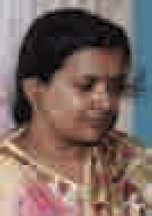With Faith and Confidence
Originally published in the WHO Goodwill Ambassador’s Newsletter for the Elimination of Leprosy, Issue No. 4 (October 2003). The information was correct and current at the time of publication.
We thank Dr. Shridhar Kadam, WHO coordinator in Orissa for this story. Dr. Kadam commented, “I love these female workers. They are so good and dedicated to the work. We owe a great deal to them.” In order to reach the nearly unreachable people living on the periphery of society, the effort of people like Hiramani Nayak is indispensable.

Hiramani Nayak
I am a health worker at the Konark Subcenter of Public Health Center Konark in the Puri District of Orissa State. Under my jurisdiction there are ten villages with a total population of 5,495. I have been in this service for the last twelve years and am educated up to higher secondary school.
On Wednesday, Immunization/Clinic Day at the subcenter, I do routine immunizations, ANC (Antenatal Clinic) check-ups and immunizations, as well as treatment of minor ailments like malaria, anemia, scabies, etc. On the same day, I also distribute MDT3 to leprosy patients. On other weekdays, I go to villages for home visits. I prepare route charts to visit the villages ahead of time, and visit every village fortnightly. All the services that I provide on Wednesday at the subcenter, I also provide during visits to people in the villages who are unable to attend a subcenter.
I have been working in leprosy since the integration in 1998. I have been trained in leprosy and participated in all four Modified Leprosy Elimination Campaigns. I have been doing routine leprosy work (i.e. taking suspected leprosy patients to a PHC Medical Officer for confirmation, giving MDT to leprosy patients and maintaining records) since 2000. At present there are three leprosy patients under treatment at my subcenter. All are MB cases and they are taking MDT regularly. They take MDT when they come to the subcenter, but if someone isn’t able to come to me, I give the MDT to that patient during a home visit.
I am quite satisfied doing anti-leprosy work because when the patients get treated with MDT, deformities are prevented. These people appreciate what I’m doing very much and become close friends of mine. Other people come to me voluntarily to show me their patches. This faith of people in me gives me job satisfaction. Thus very easy diagnosis and definite cure by MDT is the thing about leprosy that enables me to work in the leprosy field very comfortably.
One example is a female MB leprosy patient who is presently taking MDT from me. She comes from quite a long distance away because she has faith and confidence in me. MDT has given me this confidence. Thanks to MDT, I know the people of my area. I am confident that they will not hide the disease from me and they will voluntarily come to me to show me their patches. Hence there is little need to actively search for new patients in my area — while some very few new cases may appear, I am quite confident that there will not be any new cases with deformities.
By Hiramani Nayak — Health Worker
